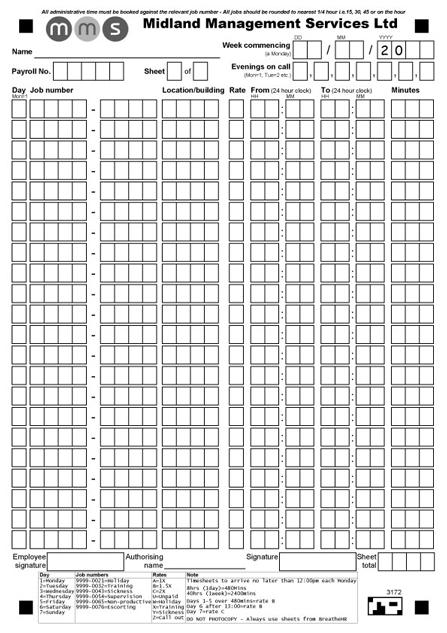Midland Management Services
MMS save 37.5 hours per week and reduce manual data entry by 80% with TeleForm-based timesheet automation system
Company / Background
Midland Management Services (MMS) provide mechanical, electrical, and building maintenance services to the public and private sector in the UK.
In recent years, MMS has built an enviable reputation for providing planned and reactive mechanical and electrical maintenance to public sector organisations, including the Ministry of Defence (MOD).
Formed in 2005, MMS have a relentless focus on managing productivity. This includes cost-effective procurement of materials and reviewing job costs to improve competitiveness and provide value for money to clients.
Challenges
Every week, over 100 employees at 20 operational sites need to submit a timesheet to a central location for manual checking and input into Excel-based management reporting systems.
The paper timesheet records start/end/total hours, job numbers, and location. The weekly timesheet must be accurate to enable MMS to pay the correct wages, monitor productivity levels and set job costings/contract rates appropriately.
Labour-intensive and inaccurate with no real-time job costing
was how Andy Pitchford, Managing Director at MMS described their old approach. This limited and delayed financial and productivity data
, he adds with several challenges identified.
Manual data capture
The data entry team was tasked with the slow and laborious task of manually inputting over 100 timesheets each week. The time-consuming process involved keying, rekeying, and checking timesheets with the work spread across two part-time teams working a combined 37.5 hours each week.
Transcription errors in data entry
A key challenge was the difficulty in spotting mistakes, leading to the risk of incorrectly calculating timesheets and inaccurate staff remuneration.
Outgrowing existing system
As the company expanded from 20 to 160 employees, its existing job costing system struggled to cope with the increasing volume of data.
The accounting software had a capacity limit of 20,000 records, but MMS completed over 70,000 jobs a year. This led to staff spending a significant amount of time deleting jobs off the system to free up space for new data entry. It was not a long-term solution and Andy felt it crucial to find a software solution to maintain job costing records.
An incomplete picture of productivity levels
The previous process did not capture enough detail to identify unproductive job costings, resulting in uncertainty when setting rates for new contract opportunities.
Outdated management information
Management information was at least a couple of months out-of-date which negatively affected decision-making.
We were never able to get accurate data in time. I was working with data that was behind and actual costs were not reconciled until the end of the financial year. Working with data in arrears restricted investment decisions and did not provide a full picture at wage reviews and setting labour rates when pricing new work.
Andy Pitchford, Managing Director, MMS
Solution
Andy needed a timesheet automation system to capture accurate job costing data, monitor profit margins, and reduce manual data entry. He spoke to three vendors and considered a commercial off-the-shelf (COTS) solution but concluded no COTS product could meet his exact requirements.
A short time later, Andy asked ePC to install a TeleForm-based timesheet automation system and provide training and technical support.
When we first spoke to ePC, the pre-sales process was low pressure and it always felt like they put our needs first. I think they actually said 500 timesheets is low volume and asked if we were sure we needed this...quite remarkable and very different to most sales teams I’ve encountered in the past.
Andy Pitchford, Managing Director, MMS
Design timesheet templates
The first stage was to design the weekly timesheet (see figure 1) in the TeleForm Designer module and create bespoke rules and lookups on the form.
An additional benefit saw the new timesheet template optimised for higher capture rates and reduced manual intervention, with clearly defined print fields, cornerstones, and barcode recognition technology. This made the form look more professional and easier to fill in.
Reduce manual data capture
At the end of the week, timesheets are scanned into TeleForm at 20 sites across the UK using high-speed document scanners.
Once scanned, TeleForm automatically processes the timesheets in the background at Head Office. The timesheet processing system reads handwritten ICR characters, enforces validation rules (e.g., match payroll number to employee name) and extracts field data in seconds.
Next, a short manual process is required to verify poor handwriting or invalid data. If TeleForm is uncertain about a field or character, it is highlighted for the administration team to review and correct if necessary.
The TeleForm training from ePC helped us to get the teams up-to-speed and filling out the forms accurately, so we are getting very few exceptions.
Andy Pitchford, Managing Director, MMS
Every line item is sanity checked for time-based math errors and overlapping times with daily and weekly totals cross-checked. The process is guaranteed for every line item on each timesheet; a validation that would have been prohibitively time-consuming and error-prone with manual data capture.
Once every timesheet has been processed, captured data is exported to SQL. Administrators can log on to eStore to search and retrieve archived forms.
Timesheet automation system leads to time savings
Sage now handles orders and material purchases with weekly timesheets scanned in TeleForm.
This has saved a significant amount of management time as Sage is now processing orders without constantly hitting its limit.
Additionally, one-click Excel downloads allow Andy to identify who has not submitted their timesheet or completed it correctly. This allows us to identify employees who continue to make errors or fail to submit timesheets on time
, says Andy.
Capture productive and unproductive jobs
From the start, Andy wanted the timesheet to identify unproductive job costings.
ePC worked closely with MMS to build bespoke rules to accurately capture unproductive time from workers’ timesheets, such as downtime, waiting time etc.
In addition to recording the time that workers spend on individual tasks each day, the new timesheet now identifies unproductive time onsite, so I know how productive our teams have been over the last 12 months. We can carry out comparative time studies for similar tasks and then weigh that up against other mitigating factors. It’s very powerful and helps us make decisions. ePC has helped us implement a process change as well as a new system.
Andy Pitchford, Managing Director, MMS
With the economic outlook uncertain, MMS now have confidence when setting new contract rates.
Near real-time management information supports better business outcomes
Andy can log on to eStore and download management reports containing timesheet data and profit margins on individual jobs from the previous week.
This allows MMS to review performance, spot trends, and manage the business better.
Results
Reduced manual data entry
Automated timesheets have reduced manual data entry time by 80%.
It’s liberating and frees our staff to do more meaningful work rather than manual data entry all week.
Mae Andrews, Finance Director, MMS
Time savings
TeleForm is very quick to process large amounts of data and has saved the equivalent of one Full-Time Equivalent (FTE) – 37.5 hours - per week with teams redeployed to more engaging, productive tasks.
Achieving cost savings
MMS has achieved significant cost savings with the TeleForm implementation.
Initially, MMS considered other options, such as Sage Business Cloud Accounting, but found it would cost significantly more per year with TeleForm costing significantly less.
TeleForm was a large investment up-front, but it has paid for itself in under two years
, says Andy. We would have undoubtedly spent more If we opted for Sage over this bespoke system. Put it this way, ePC delivered what we specified, and I haven’t been disappointed
.
Competitive job costings
With a commitment to reduce costs for the MoD, MMS needed certainty that their pricing was viable when setting contract rates.
TeleForm has been absolutely fundamental in allowing us to set competitive job costings
, says Andy. The accuracy of timesheet data has allowed us to negotiate pricing at the item level for every single job we undertake
.
The importance of setting viable pricing is emphasised by the fact we have been awarded new contracts after competitors withdrew from sites due to poor financial results, allowing us to successfully expand the MMS business
, reflects Andy.
Andy goes further and suggests the system has helped MMS win new contracts.
Some contract award dates were delayed due to the pandemic, and we were fortunate that the system was in place when the new dates were announced as we had accurate data and could make better decisions
, he says.
Supports remote working
TeleForm supports a mobile workforce who submit timesheets on the road while administrators work from home.
We thank our lucky stars we did switch from manual processing to an automated timesheet system before the COVID-19 pandemic hit. I think we would have struggled with the way we used to manually collect the faxes and input the data with everyone working from home. It would have been a nightmare to input over 100 faxes every week while working remotely
, concludes Andy.
To learn more about our timesheet processing solutions, please contact us or call 03300 100 000.

